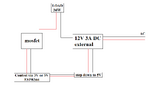SentinelAeon
Member
I need an advice on which mosfet will work for my project. I am running a 12V 3A load. I am using ESP8266 to turn it on/off. The system will change state up to 100.000 per year, maybe more in future, each state can be as short as 1 minute or as long as 30 minutes.
specs.:
- at least 12V, 3A
specs.:
- at least 12V, 3A


